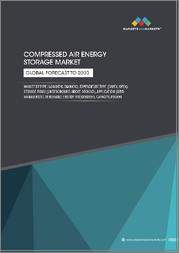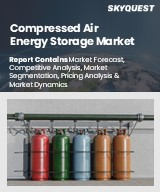
|
시장보고서
상품코드
1636056
세계의 압축 공기 에너지 저장(CAES) 시장 : 유형별, 저장 유형별, 용도별, 지역별(2025-2033년)Compressed Air Energy Storage (CAES) Market by Type (Adiabatic, Diabatic, Isothermal), Storage Type (Constant-Volume Storage, Constant-Pressure Storage), Application (Power Station, Distributed Energy System, Automotive Power), and Region 2025-2033 |
||||||
IMARC Group은 2024년 압축 공기 에너지 저장(CAES) 시장 세계 시장 규모가 66억 달러에 달했으며, 2025년부터 2033년까지 19.49%의 연평균 성장률(CAGR)로 2033년에는 351억 달러에 달할 것으로 예측했습니다. 에너지 부문의 급속한 성장, 전력 생산 증가, 해상 풍력 터빈의 CAES 채택 증가가 시장을 이끄는 주요 요인 중 하나입니다.
CAES는 지하 저장탱크에서 공기를 압축해 에너지를 저장하는 방식입니다. 회전식 압축기로 공기를 압축하는 가스 터빈 사이클을 이용합니다. 공기를 팽창시켜 저장된 에너지를 회수하고, 고압의 공기를 터빈을 통해 발전하는 방식입니다. 전력 수요가 많은 시간대에 에너지 사용량을 보충하고, 공기의 질을 높이고, 시스템의 안정성을 유지하는 데 사용됩니다. 이를 통해 에너지 회사는 추가 에너지 생산 없이도 서비스 지역 전체에 충분한 에너지를 공급할 수 있습니다. 전력망에 대한 의존도를 낮추고 에너지 요금과 운영 비용을 절감합니다. 전기 인프라에 대한 부담을 줄이고 에너지 신뢰성을 향상시켜 전력망의 안정성을 높이며, CAES는 압축기를 언로드한 후 재가동하기 때문에 수명이 길고 짧은 사이클을 줄일 수 있으며, CAES는 압축기의 유지보수 빈도를 줄여 유지보수 비용이 거의 들지 않고, 유지보수 비용이 거의 들지 않습니다. 유지보수 비용이 거의 들지 않아 전 세계적으로 수요가 증가하고 있습니다.
CAES 시장 동향 :
현재 전 세계적으로 전력 수급을 충족시키기 위해 풍력, 태양광, 수력 등 재생에너지에 의한 전력 생산이 증가하고 있습니다. 이는 전력계통 운영자 및 발전사업자의 전력 저장을 위한 CAES 사용 증가와 함께 시장 성장을 뒷받침하는 중요한 요인 중 하나가 되고 있습니다. 또한, 전력 수요 피크 시 전력망에 에너지 공급을 보장하기 위한 CAES에 대한 수요 증가도 시장에 긍정적인 영향을 미치고 있습니다. 또한, 열교환기에 의존하여 내부와 외부의 온도를 항상 동일하게 유지하는 등온 저장에 대한 수요도 증가하고 있습니다. 이는 전 세계 에너지 부문의 번영과 함께 CAES에 대한 수요를 자극하고 있습니다. 이와는 별도로, 비용 효율성과 환경적 고려로 인해 해상 풍력 터빈에서 CAES의 채택이 증가하고 있으며, 시장 전망은 양호합니다. 이에 따라 노후화된 전력망의 안정성을 보장하고 석탄 기반 발전을 천연가스로 대체하기 위한 CAES 수요 증가는 업계 투자자들에게 유리한 성장 기회를 제공합니다. 또한, 에너지 신뢰성 향상과 같은 CAES 활용의 이점에 대한 대중의 인식이 높아지면서 시장 성장에 힘을 실어주고 있습니다.
본 보고서에서 다룬 주요 질문
- 세계 CAES 시장은 지금까지 어떻게 성장해왔고, 앞으로 어떻게 발전할 것인가?
- 세계 CAES 시장 성장 촉진요인, 억제요인 및 기회는 무엇인가?
- 각 촉진요인, 억제요인 및 기회가 CAES 시장의 세계에 미치는 영향은?
- 주요 지역 시장은?
- CAES 시장에서 가장 매력적인 국가는 어디일까?
- 유형별 시장 분석은?
- CAES 시장에서 가장 매력적인 유형은?
- 저장 유형별 시장 현황은?
- CAES 시장에서 가장 매력적인 저장 유형은?
- 용도별 시장 현황은?
- CAES 시장에서 가장 매력적인 용도는?
- 세계 CAES 시장 경쟁 구도는?
- 세계 CAES 시장의 주요 기업은?
목차
제1장 서문
제2장 조사 범위와 조사 방법
- 조사 목적
- 이해관계자
- 데이터 소스
- 1차 정보
- 2차 정보
- 시장 추정
- 보텀업 접근
- 톱다운 접근
- 조사 방법
제3장 주요 요약
제4장 서론
- 개요
- 주요 업계 동향
제5장 세계의 압축 공기 에너지 저장(CAES) 시장
- 시장 개요
- 시장 실적
- COVID-19의 영향
- 시장 예측
제6장 시장 분석 : 유형별
- 단열
- 시장 동향
- 시장 예측
- 비단열
- 시장 동향
- 시장 예측
- 등온
- 시장 동향
- 시장 예측
제7장 시장 분석 : 저장 유형별
- 정량 저장
- 시장 동향
- 시장 예측
- 정압 저장
- 시장 동향
- 시장 예측
제8장 시장 분석 : 용도별
- 발전소
- 시장 동향
- 시장 예측
- 분산형 에너지 시스템
- 시장 동향
- 시장 예측
- 자동차용 전력
- 시장 동향
- 시장 예측
제9장 시장 분석 : 지역별
- 북미
- 미국
- 캐나다
- 아시아태평양
- 중국
- 일본
- 인도
- 한국
- 호주
- 인도네시아
- 기타
- 유럽
- 독일
- 프랑스
- 영국
- 이탈리아
- 스페인
- 러시아
- 기타
- 라틴아메리카
- 브라질
- 멕시코
- 기타
- 중동 및 아프리카
제10장 성장 촉진요인 및 억제요인과 기회
- 개요
- 성장 촉진요인
- 성장 억제요인
- 기회
제11장 밸류체인 분석
제12장 Porter의 Five Forces 분석
- 개요
- 바이어의 교섭력
- 공급 기업의 교섭력
- 경쟁 정도
- 신규 진출업체의 위협
- 대체품의 위협
제13장 가격 분석
제14장 경쟁 구도
- 시장 구조
- 주요 기업
- 주요 기업 개요
- Alacaes Sa
- Apex Compressed Air Energy Storage LLC
- Hydrostor Inc.
- Pacific Gas and Electric Company
- Storelectric Limited
The global compressed air energy storage (CAES) market size reached USD 6.6 Billion in 2024. Looking forward, IMARC Group expects the market to reach USD 35.1 Billion by 2033, exhibiting a growth rate (CAGR) of 19.49% during 2025-2033. The burgeoning energy sector, rising production of electricity, and the growing employment of CAES in offshore wind turbines represent some of the key factors driving the market.
Compressed air energy storage (CAES) is a method of storing energy by compressing air in an underground storage reservoir. It relies on the gas turbine cycle that is used to compress air using a rotary compressor. It helps retrieve stored energy by allowing the air to expand, which pushes high-pressure air through a turbine to create electricity. It is used to supplement energy usage during high-demand periods, enhance air quality, and maintain system stability. It allows energy companies to provide sufficient energy for the entire service area without the need for added energy production. It reduces dependency on the electrical grid and decreases energy charges and operational overhead. It enhances power grid stability by lowering the strain on the electrical infrastructure and improving energy reliability. It offers a long shelf-life as CAES allows the compressor to unload before starting again and reduces short cycling. As it requires little maintenance costs due to reduced compressor maintenance frequency, the demand for CAES is rising across the globe.
Compressed Air Energy Storage (CAES) Market Trends:
At present, there is a rise in the production of electricity from renewable sources, such as wind, solar, and water energy, to meet the supply and demand for electricity across the globe. This, along with the increasing utilization of CAES by electricity system operators and electricity generators to store electricity, represents one of the key factors supporting the growth of the market. In addition, the growing demand for CAES to ensure the provision of the electrical grid with energy during peak demand periods is positively influencing the market. Moreover, there is an increase in the demand for isothermal storage that relies on heat exchangers to always keep the internal and external temperatures same. This, coupled with the thriving energy sector around the world, is catalyzing the demand for CAES. Apart from this, the growing employment of CAES in offshore wind turbines due to its cost-effectiveness and environment-friendliness is offering a favorable market outlook. In line with this, the increasing demand for CAES to ensure the stability of the aging power grid and replace coal-based electricity generation with natural gas is providing lucrative growth opportunities to industry investors. Additionally, the rising awareness among the masses about the benefits of using CAES, such as increased energy reliability, is strengthening the growth of the market.
Key Market Segmentation:
Type Insights:
- Adiabatic
- Diabatic
- Isothermal
Storage Type Insights:
- Constant-Volume Storage
- Constant-Pressure Storage
Application Insights:
- Power Station
- Distributed Energy System
- Automotive Power
Regional Insights:
- North America
- United States
- Canada
- Asia Pacific
- China
- Japan
- India
- South Korea
- Australia
- Indonesia
- Others
- Europe
- Germany
- France
- United Kingdom
- Italy
- Spain
- Russia
- Others
- Latin America
- Brazil
- Mexico
- Others
- Middle East and Africa
- The report has also provided a comprehensive analysis of all the major regional markets that include North America (the United States and Canada); Asia Pacific (China, Japan, India, South Korea, Australia, Indonesia, and others); Europe (Germany, France, the United Kingdom, Italy, Spain, Russia, and others); Latin America (Brazil, Mexico, and others); and the Middle East and Africa. According to the report, North America was the largest market for compressed air energy storage (CAES). Some of the factors driving the North America compressed air energy storage (CAES) market included the increasing demand for energy storage, rising adoption of renewable energy sources, and government support for energy efficient technologies.
Competitive Landscape:
- The report has also provided a comprehensive analysis of the competitive landscape in the global compressed air energy storage (CAES) market. Competitive analysis such as market structure, market share by key players, player positioning, top winning strategies, competitive dashboard, and company evaluation quadrant has been covered in the report. Also, detailed profiles of all major companies have been provided. Some of the companies include Alacaes SA, Apex Compressed Air Energy Storage LLC, Hydrostor Inc., Pacific Gas and Electric Company, Storelectric Limited, etc. Kindly note that this only represents a partial list of companies, and the complete list has been provided in the report.
Key Questions Answered in This Report:
- How has the global compressed air energy storage (CAES) market performed so far and how will it perform in the coming years?
- What are the drivers, restraints, and opportunities in the global compressed air energy storage (CAES) market?
- What is the impact of each driver, restraint, and opportunity on the global compressed air energy storage (CAES) market?
- What are the key regional markets?
- Which countries represent the most attractive compressed air energy storage (CAES) markets?
- What is the breakup of the market based on the type?
- Which is the most attractive type in the compressed air energy storage (CAES) market?
- What is the breakup of the market based on the storage type?
- Which is the most attractive storage type in the compressed air energy storage (CAES) market?
- What is the breakup of the market based on the application?
- Which is the most attractive application in the compressed air energy storage (CAES) market?
- What is the competitive structure of the global compressed air energy storage (CAES) market?
- Who are the key players/companies in the global compressed air energy storage (CAES) market?
Table of Contents
1 Preface
2 Scope and Methodology
- 2.1 Objectives of the Study
- 2.2 Stakeholders
- 2.3 Data Sources
- 2.3.1 Primary Sources
- 2.3.2 Secondary Sources
- 2.4 Market Estimation
- 2.4.1 Bottom-Up Approach
- 2.4.2 Top-Down Approach
- 2.5 Forecasting Methodology
3 Executive Summary
4 Introduction
- 4.1 Overview
- 4.2 Key Industry Trends
5 Global Compressed Air Energy Storage (CAES) Market
- 5.1 Market Overview
- 5.2 Market Performance
- 5.3 Impact of COVID-19
- 5.4 Market Forecast
6 Market Breakup by Type
- 6.1 Adiabatic
- 6.1.1 Market Trends
- 6.1.2 Market Forecast
- 6.2 Diabatic
- 6.2.1 Market Trends
- 6.2.2 Market Forecast
- 6.3 Isothermal
- 6.3.1 Market Trends
- 6.3.2 Market Forecast
7 Market Breakup by Storage Type
- 7.1 Constant-Volume Storage
- 7.1.1 Market Trends
- 7.1.2 Market Forecast
- 7.2 Constant-Pressure Storage
- 7.2.1 Market Trends
- 7.2.2 Market Forecast
8 Market Breakup by Application
- 8.1 Power Station
- 8.1.1 Market Trends
- 8.1.2 Market Forecast
- 8.2 Distributed Energy System
- 8.2.1 Market Trends
- 8.2.2 Market Forecast
- 8.3 Automotive Power
- 8.3.1 Market Trends
- 8.3.2 Market Forecast
9 Market Breakup by Region
- 9.1 North America
- 9.1.1 United States
- 9.1.1.1 Market Trends
- 9.1.1.2 Market Forecast
- 9.1.2 Canada
- 9.1.2.1 Market Trends
- 9.1.2.2 Market Forecast
- 9.1.1 United States
- 9.2 Asia-Pacific
- 9.2.1 China
- 9.2.1.1 Market Trends
- 9.2.1.2 Market Forecast
- 9.2.2 Japan
- 9.2.2.1 Market Trends
- 9.2.2.2 Market Forecast
- 9.2.3 India
- 9.2.3.1 Market Trends
- 9.2.3.2 Market Forecast
- 9.2.4 South Korea
- 9.2.4.1 Market Trends
- 9.2.4.2 Market Forecast
- 9.2.5 Australia
- 9.2.5.1 Market Trends
- 9.2.5.2 Market Forecast
- 9.2.6 Indonesia
- 9.2.6.1 Market Trends
- 9.2.6.2 Market Forecast
- 9.2.7 Others
- 9.2.7.1 Market Trends
- 9.2.7.2 Market Forecast
- 9.2.1 China
- 9.3 Europe
- 9.3.1 Germany
- 9.3.1.1 Market Trends
- 9.3.1.2 Market Forecast
- 9.3.2 France
- 9.3.2.1 Market Trends
- 9.3.2.2 Market Forecast
- 9.3.3 United Kingdom
- 9.3.3.1 Market Trends
- 9.3.3.2 Market Forecast
- 9.3.4 Italy
- 9.3.4.1 Market Trends
- 9.3.4.2 Market Forecast
- 9.3.5 Spain
- 9.3.5.1 Market Trends
- 9.3.5.2 Market Forecast
- 9.3.6 Russia
- 9.3.6.1 Market Trends
- 9.3.6.2 Market Forecast
- 9.3.7 Others
- 9.3.7.1 Market Trends
- 9.3.7.2 Market Forecast
- 9.3.1 Germany
- 9.4 Latin America
- 9.4.1 Brazil
- 9.4.1.1 Market Trends
- 9.4.1.2 Market Forecast
- 9.4.2 Mexico
- 9.4.2.1 Market Trends
- 9.4.2.2 Market Forecast
- 9.4.3 Others
- 9.4.3.1 Market Trends
- 9.4.3.2 Market Forecast
- 9.4.1 Brazil
- 9.5 Middle East and Africa
- 9.5.1 Market Trends
- 9.5.2 Market Breakup by Country
- 9.5.3 Market Forecast
10 Drivers, Restraints, and Opportunities
- 10.1 Overview
- 10.2 Drivers
- 10.3 Restraints
- 10.4 Opportunities
11 Value Chain Analysis
12 Porters Five Forces Analysis
- 12.1 Overview
- 12.2 Bargaining Power of Buyers
- 12.3 Bargaining Power of Suppliers
- 12.4 Degree of Competition
- 12.5 Threat of New Entrants
- 12.6 Threat of Substitutes
13 Price Analysis
14 Competitive Landscape
- 14.1 Market Structure
- 14.2 Key Players
- 14.3 Profiles of Key Players
- 14.3.1 Alacaes Sa
- 14.3.1.1 Company Overview
- 14.3.1.2 Product Portfolio
- 14.3.2 Apex Compressed Air Energy Storage LLC
- 14.3.2.1 Company Overview
- 14.3.2.2 Product Portfolio
- 14.3.3 Hydrostor Inc.
- 14.3.3.1 Company Overview
- 14.3.3.2 Product Portfolio
- 14.3.4 Pacific Gas and Electric Company
- 14.3.4.1 Company Overview
- 14.3.4.2 Product Portfolio
- 14.3.4.3 Financials
- 14.3.4.4 SWOT Analysis
- 14.3.5 Storelectric Limited
- 14.3.5.1 Company Overview
- 14.3.5.2 Product Portfolio
- 14.3.1 Alacaes Sa
Kindly note that this only represents a partial list of companies, and the complete list has been provided in the report.



















